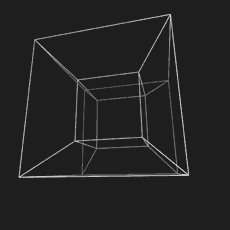The 4th Dimension and our Minds
We humans life in a three-dimensional world. Those three dimensions are commonly known as length, width, and height. An example of a three-dimensional shape is a cube.
Whether an object is three-dimensional or two-dimensional, our minds can visualize what that object may be or look like. When we jump into shapes that are in the 4th dimension however, our minds get fuzzy and we scratch our heads in confusion. If we can think about how the volumes of shapes play a role in number of dimensions a shape has, then it's quite straightforward. The volume of a side of a cube has the expression, x3 or "x cubed". This means that for a hypercube it is simply x4.
The animation above shows what is commonly known as a four-dimensional cube: a hypercube, or tesseract. The 4D object is being rotated for us to sense its higher dimensions. In other words, without adding a time element to our appreciation of the shape shown in this animation, a significant part of what makes this a unique shape remains unseen. In the animation above, we are looking on our computer screen which lies on a flat 2D representation. This screen is of a 3D shadow, which is of a 4D object. Confusing right?
Under this text there is another animation, again showing a pair rotating hypercubes. In this one, try moving your eyes so close to the monitor that your left eye sees the left half of the image and your other eye sees the right, your brain (with a bit of practice) can then merge those two halves into an illusion that enhances the depth for one full visualization. From this, you can get a hint of what's really happening here: "shadows" of a 4D shape are being seen from the 3rd dimension.
https://vignette.wikia.nocookie.net/alldimensions/images/6/64/Tesseract_the_four-dimensional_hypercube_-GIF-_-_Imgur.gif/revision/latest?cb=20130219082716
The animation above shows what is commonly known as a four-dimensional cube: a hypercube, or tesseract. The 4D object is being rotated for us to sense its higher dimensions. In other words, without adding a time element to our appreciation of the shape shown in this animation, a significant part of what makes this a unique shape remains unseen. In the animation above, we are looking on our computer screen which lies on a flat 2D representation. This screen is of a 3D shadow, which is of a 4D object. Confusing right?
Under this text there is another animation, again showing a pair rotating hypercubes. In this one, try moving your eyes so close to the monitor that your left eye sees the left half of the image and your other eye sees the right, your brain (with a bit of practice) can then merge those two halves into an illusion that enhances the depth for one full visualization. From this, you can get a hint of what's really happening here: "shadows" of a 4D shape are being seen from the 3rd dimension.
https://i.gifer.com/91vw.gif
This concept of shadows of a 4-D shape being perceived from the third dimension reminded me of the Nintendo Virtual Boy. It was a failed Nintendo product sold in 1995 that sat on store shelves for less than a year. It's main target was to bring 3-D to the gaming audience. Like the animation above, there were two windows you would look into and together from shadows would see one image. The default and only color that the Virtual Boy produced when you were using it was a "laser red" color, which is one of the leading factors of why it could've failed. Red light cut down on costs but put gamers paying a major price at their health's expense. See, this red light caused eye-strain, headaches, and even seizures if played more than 15 minutes at a time. Plus, the uncomfortable position you had to play at was another reason for gamer's to stay away from the Virtual Boy and instead purchase a console like the Sony PlayStation.
https://www.gamebits.net/wp-content/uploads/2016/11/Virtual-Boy-03.jpg
One game that really struck my attention and made me think about the fourth dimension was the game Red Alarm, which was a wire-frame shooter platform.
https://i.ytimg.com/vi/KyLpQFCAkQo/maxresdefault.jpg
This game brings confusion but also expresses the factor of the fourth-dimension or tesseract. Since the game is made up of entirely lines, it is disorienting and very hard to see where the boundaries are since there is no texture. Many times when I used to play this game, I would often think that I was flying into an opening but it came down to just flying into more lines. Vice versa, sometimes I would believe that I was just flying into a wall but actually it was an opening. Very confusing but cool that for it's time took advantage trying to have gamers play in the 4th dimension.






Comments
Post a Comment